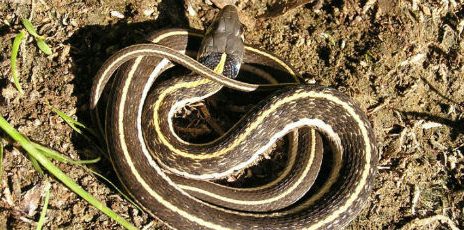External Links for Black-necked Gartersnake
Black-necked Gartersnake
Thamnophis cyrtopsis

Identification
Black-necked gartersnakes are striped gartersnakes, typically with a dark grey or olive-grey background color, two whitish or cream-colored side stripes on the 2nd and 3rd scale rows, and a thick, bright mid-dorsal (center of the back) stripe. The mid-dorsal stripe is strongly yellow or orange on the anterior part (closest to the head) of the body, while the side stripes are often white, resulting in a very brightly contrasting overall appearance. Black-necked gartersnakes typically have very obvious paired black neck patches on either side of the dorsal stripe at the back of the head, and the head is bluish-grey. There are obvious black stripes outlining the cream-colored or whitish labial scales on the upper and lower jaws. Adult female black-necked gartersnakes may reach 42 inches in total length (1,070 mm; Brennan and Holycross 2006).
These snakes may be confused with northern Mexican gartersnakes and western terrestrial gartersnakes, but typically black-necked gartersnakes have a much brighter yellow or orange mid-dorsal stripe paired with striking black neck blotches. Northern Mexican gartersnakes have side stripes on the 3rd and 4th scale rows.
Distribution
This snake is found across southeastern and central Arizona. An isolated population exists in the Ajo Mountains of western Pima County. In Arizona it ranges in elevation from 1,100′ in the Phoenix basin to about 7,000′ in Mogollon Rim country. It inhabits a wide variety of biotic communities including Sonoran Desert scrub, Semidesert Grassland, Interior Chaparral, Madrean Evergreen Woodland, Great Basin Conifer Woodland, Plains Grassland, Great Basin Grassland, and Petran Montane Conifer Forest. It is usually found near water in rocky upland canyons and along semi-permanent streams and drainages. It occasionally wanders far from water.
Ecology
Although primarily diurnal and crepuscular it is occasionally active on warm nights. It is often encountered mid-morning or late afternoon foraging for tadpoles in shallow water. In addition to tadpoles this snake eats frogs, toads, lizards, salamanders and invertebrates, It hibernates during the cold months of late fall and winter. It gives birth to up to up to 25 young in late spring or summer.
(Distribution and Ecology information by Thomas C. Brennan)